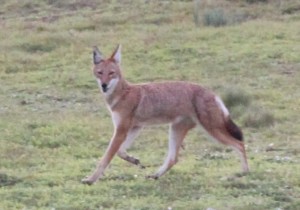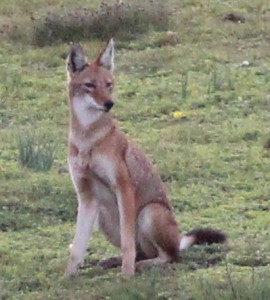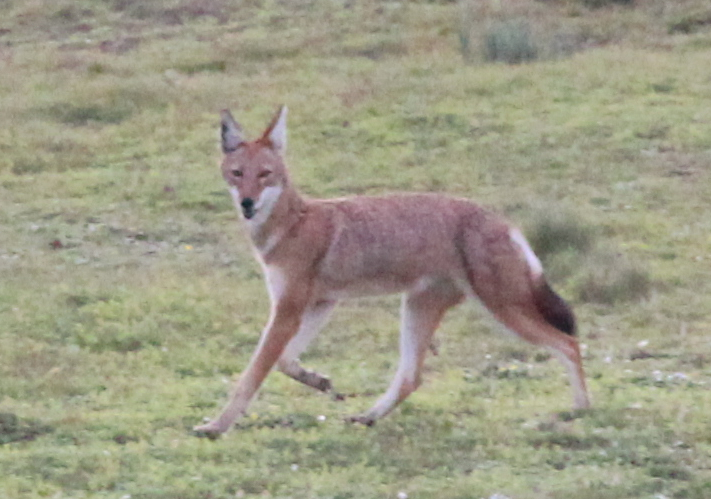22 June 2012
After a long and rewarding day with the monkeys, the sun began to dip towards the horizon. Tyler suggested we leave the monkeys early to go looking for wolves. Ethiopian wolves are one of the highlights of Guassa, and Tyler didn’t want me to leave without seeing one.
Ethiopian wolves, like gelada monkeys, are endemic to the Ethiopian highlands: they don’t occur anywhere else. The highlands are so different and isolated from the surrounding lands that all sorts of unusual things have evolved here.
They are small for a wolf. They don’t get much bigger than 40 pounds. They eat mainly rodents, which are abundant at Guassa. The wolves don’t seem to pose any sort of threat to gelada monkeys, despite being depicted as hunting geladas in at least one nature documentary. They look more like a large fox or a coyote than a wolf, with a reddish coat. And indeed, when speaking English, Ethiopians seem to mainly call them “red foxes.”
But genetically, they are closely related to grey wolves, having diverged from them some 3-4 million years ago. And they are extremely rare. Only about 550 of them survive in the wild, of which something like 30 live at Guassa.
Before we left the monkeys, Tyler talked to Tayler, who has been searching for wolves on his days off. Taylor recommended several spots, including the big valley close to camp. So we left the monkeys and walked back towards camp, stopping now and then to look for wolves. As we approached the valley, we left the road and climbed a hill that gave a broad view across the valley. Tyler scanned the valley with binoculars, and before too long, found a pair of wolves on a distant ridge. With some help, I eventually found them too.
We sat on the hillside and watched the wolves, which were far beyond camera range. After a few minutes, the wolves trotted up the hill and out of view. Tyler said the wolves were shy, and I wasn’t expecting get close enough to take pictures; I was excited just to have caught a glimpse of these rare creatures.
We sat and scanned the valley some more, and eventually Tyler spotted two more wolves, some six or seven hundred meters away, on the other side of the valley, close to the road. People herding cattle or driving down the road didn’t seem to notice the wolves at all. I wondered how many times we had walked past wolves without seeing them. Despite their reddish-orange and white coats, they blended easily into the green-grey heathland. When I put the binoculars down to rest my eyes a bit, I couldn’t see the wolves at all with my naked eyes, and had trouble finding them again with the binoculars.
Peter commented that these four wolves represented nearly 1% of the entire population of the species. They are reasonably well protected on Guassa, but still face threats, such as rabies, which has killed hundreds of wolves, and cars, which occasionally kill wolves crossing the road.
Tyler speculated that these two wolves we were looking at now might be the grown offspring of the pair we had seen earlier. After watching the wolves through binoculars for a good long time, Tyler suggested we try moving closer to them. We walked slowly down the hill. Tyler suggested we walk towards a ridge that ran between us and the wolves, so we could get closer to them without them seeing us. The plan worked a little too well. By the time we climbed the top of that ridge, we found that one of the wolves walking right past us, and it startled, running another hundred meters or so away from us before turning back to look at us. We watched it slowly walk away, then began making our way to camp.
I lagged behind to put my camera away and take a GPS reading. Tyler and Peter walked ahead to the road. Suddenly I heard them calling “Mike! Mike!” I wondered if they worried I was lost. I called out, “I’m here!” then saw why they were yelling: a wolf was running right toward me! I hurried to get my camera out. Putting the camera away seemed to be a sure way to attract wolves.
 Peter and Tyler had caught this wolf by surprise, and it quickly ran away, off towards the same direction where the other wolf had gone. Now it got another surprise: me. But though it seemed startled to see me, it didn’t seem especially concerned. It trotted past me, then turned to look at me, letting me take some pictures.
Peter and Tyler had caught this wolf by surprise, and it quickly ran away, off towards the same direction where the other wolf had gone. Now it got another surprise: me. But though it seemed startled to see me, it didn’t seem especially concerned. It trotted past me, then turned to look at me, letting me take some pictures.

It even sat down and scratched itself a bit.

Then it hunted in the heather for rats: peering into the heather and then making funny bouncing hops towards its prey. It failed to catch anything, then trotted away at a leisurely pace.
